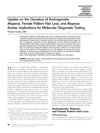Search
forLearn
1 / 1 resultsResearch
5 / 1000+ results
research Update on the Genetics of Androgenetic Alopecia, Female Pattern Hair Loss, and Alopecia Areata: Implications for Molecular Diagnostic Testing
Genetic factors affect hair loss, and molecular testing may help predict, diagnose, and treat it.
research Diagnostic Challenges in Ovarian Hyperthecosis: Clinical Presentation with Subdiagnostic Testosterone Levels
Ovarian hyperthecosis can cause symptoms even with normal testosterone levels, and surgery can improve these symptoms.
research Unusual Acute Lupus Hemophagocytic Syndrome – A Test of Diagnostic Criteria: A Case Report
The 2012 criteria are better for diagnosing atypical lupus cases.

research Ratio of Ovarian Stroma and Total Ovarian Area by Ultrasound in Prediction of Hyperandrogenemia in Reproductive-Aged Thai Women with Polycystic Ovary Syndrome: A Diagnostic Test
Ultrasound measurement of the ovarian stroma to total area ratio is not a reliable single predictor of high male hormone levels in Thai women with PCOS, but works better when combined with clinical signs.

research Diagnostic Challenges in Determining Alopecia Areata
Diagnosing alopecia areata is challenging and requires careful examination and various tests to distinguish it from other hair loss types.
Community Join
5 / 305 resultscommunity Estradiol blood test on fin. Doctor dont want to give me the test.
The user has been taking 0.5 finasteride for 10 months and wants to repeat blood tests, including estradiol. However, their doctor is reluctant to test estradiol, arguing it's typically low in men, and the user is considering seeking a second opinion.
community 5 months topical spiro + minox + micro
A 35-year-old male uses topical minoxidil, spironolactone, and microneedling for hair loss, with spironolactone prescribed based on a DNA test indicating poor response to finasteride and dutasteride. Despite concerns about the test's validity and spironolactone's side effects, he reports stable or improved hair condition and no low testosterone symptoms.
community Why is Finasteride seen as “scary” for men, but hormonal birth control is totally normalized for women?
Finasteride is seen as risky for men due to side effects like erectile dysfunction, while hormonal birth control for women is normalized despite its side effects. The discussion points out a double standard influenced by societal and gender norms.
community Can we once and for all clarify whether tretinoin helps or hurts hair?
Tretinoin's effect on hair loss is debated; some say it improves minoxidil's effectiveness, while others claim it causes hair loss. Treatments discussed include tretinoin, minoxidil, finasteride, RU58841, and dermarolling.
community Blood test showing major reduction in DHT on finasteride results
A user reported a significant reduction in DHT levels after 3 months of taking 1mg/day oral finasteride, along with using minoxidil foam, microneedling, and Nutrafol vitamins. They hope this will lead to hair growth and less shedding.